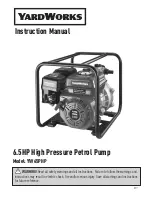
Installation
Grounding
Grounding
Grounding
This equipment must be grounded to reduce the
risk of static sparking and electric shock. Electric
or static sparking can cause fumes to ignite or
explode. Improper grounding can cause electric
shock. Grounding provides an escape wire for the
electric current.
1.
Pump:
Pump:
Pump: See Fig. 4. Loosen the ground screw and
attach a ground wire. Tighten the ground screw
securely. Connect the other end of the ground
wire to a true earth ground.
NOTE:
NOTE:
NOTE: Advanced models require installation
of the 24P822 Control Module. All pumps
connected to a common control module must be
grounded to the same ground point. Different
ground points (unequal potential) may cause
current to flow through component cables,
causing incorrect signals.
Figure 4 Ground Wire
2.
Fluid
Fluid
Fluid hoses:
hoses:
hoses: Use only electrically conductive
hoses with a maximum of 500 ft. (150 m)
combined hose length to ensure grounding
continuity. Check the electrical resistance of
hoses. If total resistance to ground exceeds 25
megohms, replace hose immediately
3.
Fluid
Fluid
Fluid supply
supply
supply container:
container:
container: Follow your local code.
4.
Solvent
Solvent
Solvent pails
pails
pails used
used
used when
when
when flushing:
flushing:
flushing: Follow local
code. Use only conductive metal pails, placed
on a grounded surface. Do not place the pail
on a non-conductive surface, such as paper or
cardboard, which interrupts grounding continuity.
5.
To
To
To maintain
maintain
maintain grounding
grounding
grounding continuity
continuity
continuity when
when
when flushing
flushing
flushing
or
or
or relieving
relieving
relieving pressure:
pressure:
pressure: Hold metal part of the spray
gun or valve firmly to the side of a grounded
metal pail, then trigger the gun or open the valve.
3A3384B
11
All manuals and user guides at all-guides.com
all-guides.com












































